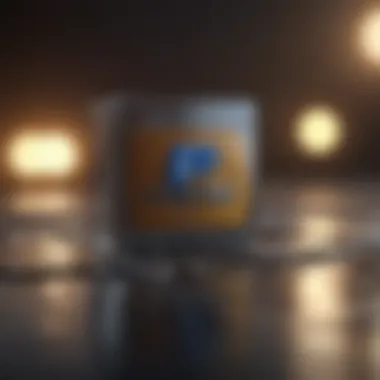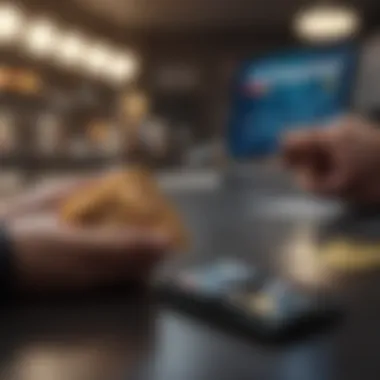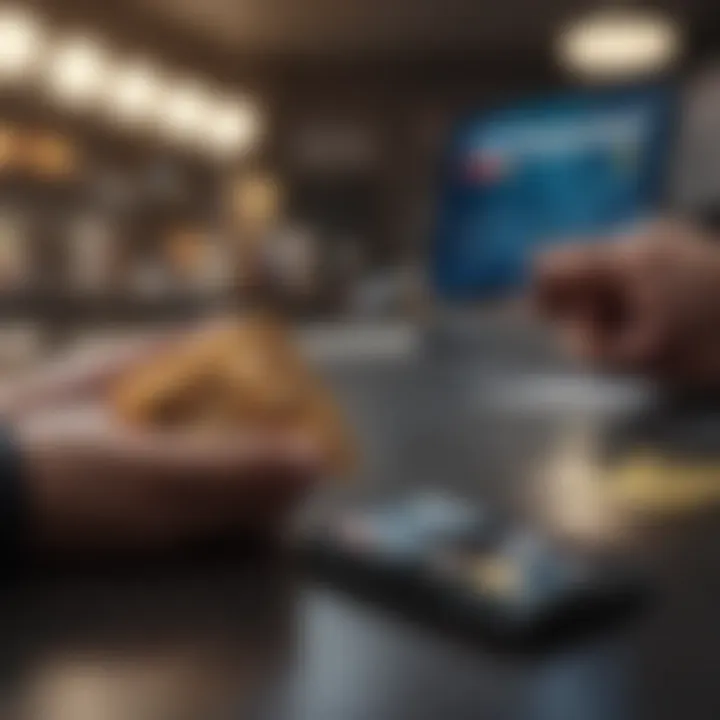Mastering PayPal Transactions Without a Credit Card


Intro
In today's fast-paced digital economy, many people are leaning on online payment platforms like PayPal to handle their transactions. However, a common misconception is that using PayPal automatically demands a credit card. This isn't entirely true. Understanding how to navigate this service without the reliance on credit cards is essential for both novice and seasoned users alike. With the rising popularity of alternative payment methods, opting out of a credit card doesn't mean compromising on security or ease of use. Instead, it opens the door to innovative methods of managing your finances online.
This guide explores the various ways you can fund your PayPal account without a credit card. Additionally, it sheds light on some key financial terms that could enhance your understanding of online transactions, as well as expert tips to help you optimize your PayPal experience.
Instead of going the usual route and signing up for yet another credit card, let’s delve into the practical options that allow you to use PayPal efficiently while keeping your finances in check.
Key Financial Terms
Understanding certain financial terms can be crucial when navigating online payment systems. Here are a few definitions and examples to clarify the jargon that may crop up as you manage your PayPal account.
Definitions
- E-Wallet: A digital form of payment that allows users to make electronic transactions. This includes services like PayPal, Venmo, and Apple Pay.
- Bank Transfer: Moving money from one bank account to another. Many PayPal users link their bank accounts for direct funding.
- Funding Source: This refers to the method used to finance your PayPal account, which could include bank transfers, debit cards, or even a cash balance in your PayPal account.
Examples of Use
- Using your e-wallet on an online marketplace makes buying easier. Once linked with a bank account, a buyer can purchase without needing physical cash.
- A bank transfer can allow users to preload their PayPal balance. This option can often be quicker than waiting for a credit card transaction to process.
- By understanding your funding source, you can make informed choices based on transaction fees, speed, and convenience. Some options may be quicker than others, depending on what you select.
Expert Tips
Beginner Strategies
If you’re new to PayPal, consider these practical approaches:
- Link a Debit Card: Instead of a credit card, linking a debit card to your PayPal account can give you similar access without incurring debt.
- Use PayPal Balance: If you plan to receive money via PayPal, consider maintaining a balance. This allows you to make immediate purchases without waiting for transfers.
Advanced Techniques
For users more familiar with the platform, consider these strategies to bolster your experience:
- Frequent Transfers: Regularly transferring funds from your bank account to PayPal can keep your balance in check without relying on credit.
- Enhanced Security: Enable two-factor authentication for added safety. This acts as the gatekeeper to your account, ensuring that unauthorized access is minimized.
"Managing your online finances doesn’t have to mean getting tangled in credit card debt. By exploring the alternatives, you pave the way for a smoother payment experience."
By understanding these terms and incorporating expert strategies, you’ll not only enhance your PayPal usage but also gain control over your financial transactions in the ever-evolving landscape of online commerce.
Prelude to PayPal
In today’s world, the way we manage our finances has dramatically transformed, with digital wallets becoming almost a daily necessity. PayPal stands out in this crowded landscape as a significant player, often acting as a bridge for transactions between consumers and businesses. It allows for the exchange of funds without the immediate need for cash or traditional banking methods, which can sometimes be a hassle. The ability to navigate PayPal without a credit card opens up a wealth of possibilities for users, particularly those who might not have access to traditional credit services.
Overview of PayPal's Functionality
PayPal operates by linking directly to bank accounts, debit cards, and other payment methods. When a user completes a transaction, the funds are pulled from their linked account, allowing for seamless transfers to and from other PayPal accounts or for online purchases in an incredibly straightforward manner. Users can send money to friends, receive payments for goods and services, and even donate to charities—all without ever seeing a physical check or cash.
Moreover, PayPal’s functionality extends to handling currency conversions and providing buyers with certain protections for their purchases. This feature is particularly important for people conducting transactions overseas or in different currencies. Users can set up recurring payments, track their spending, and manage subscriptions, giving them an overview of their financial commitments.
Importance of Digital Payment Systems
The advent of digital payment systems has reshaped consumer behavior. In many ways, it’s changed how we think about spending, saving, and tracking our money. PayPal has played a pivotal role in this transformation. The platform promotes financial inclusivity, as it makes e-commerce accessible to those who may not own a credit card. Every transaction one conducts through PayPal contributes to a larger ecosystem that enhances commerce at both individual and organizational levels.
For those hesitant to rely on credit cards, PayPal offers an alternative route. It enables users to maintain control over their finances while ensuring that fraud protection measures are in place. With various methods to fund an account, users can still enjoy the benefits of convenience and accessibility that digital payments provide. This flexibility is crucial—especially when you consider the growing reliance on e-commerce.
"Digital payment systems are no longer a luxury—they've become a part of daily life for millions, shaping how we consume and interact with finances."
Understanding PayPal's Payment Mechanisms
When it comes to online transactions, having a grasp on paymenyt mechanisms is essential for making the most of your financial tools. PayPal, as a leading digital payment platform, allows users to engage with a broad range of payment methods even without a credit card. Understanding these mechanisms not only increase user confidence but also facilitates smoother transactions, thus showcasing PayPal's flexibility and robustness in the modern financial landscape.
How PayPal Works
To unloock the full potential of PayPal, it's crucial to delve into its core functionality. At its essence, PayPal acts like a digital conduit that bridges the gap between your linked financial sources—this could be bank accounts or balances—and the recipient of your payments. When you make a payment, PayPal securely processes the transaction, keeping sensitive information away from the hands of merchants.
- User Accounts: When you sign up for PayPal, you're creating a digital wallet. This wallet can hold multiple funding sources. Users can access their account from any device with an internet connection, making it convenient to manage finances on the go.
- Payment Processing: Once you select your funding source, PayPal transfers the funds to the recipient minus any applicable fees. This process generally takes a matter of seconds.
- Currency Conversion: If you're dealing with international payments, PayPal automatically converts currencies at the prevailing exchange rate. This function is particularly useful for e-commerce businesses operating across borders.
"Knowing how PayPal works is like having a roadmap in this digital financial landscape, guiding you through each transaction with ease."
Despite the inherent advantages, it's also wise to be aware of some fees PayPal may impose. These can include transaction fees when sending money overseas or withdrawing your balance to a bank account. Nonetheless, for many, the convenience outweighs the costs.


User Account Type Overview
Now, let’s chat about the different types of accounts available on PayPal—a basic understanding can significantly affect how one engages with the platform.
- Personal Accounts: Most users start here. These accounts allow individuals to send and receive money, making it perfect for casual users. Features include money transfers, linking to bank accounts, and managing a PayPal balance.
- Business Accounts: For those running a company, a business account offers additional features. This type allows for invoicing, integration with e-commerce platforms, and access to customer analytics tools. If you're looking to expand your market reach, this is the way to go.
- Premier Accounts: Although somewhat outdated now, some users may still find themselves with a premier account. This type consolidates the personal and business features but lacks some aspects of the modern business account design.
Understanding these account types is crucial for choosing the right one based on your needs. For instance, a sole trader might do just fine with a personal account, while a medium-sized enterprise would benefit from the specialized features of a business account.
In summary, comprehending PayPal's various payment mechanisms and account types is the first step to unlocking potential. It can help steer you toward optimal financial management and smoother online navigation.
Funding a PayPal Account Without a Credit Card
In the modern landscape of online transactions, the ability to utilize PayPal without a credit card holds significant importance for many users. This section delves into various methods available for funding a PayPal account, showcasing a mixture of advantages involved and practical considerations. Understanding how to effectively add funds to a PayPal account without relying on credit can empower users to navigate their financial journeys with greater autonomy and control.
Linking Bank Accounts
Linking a bank account to your PayPal profile offers a simple and reliable way to fund your account without needing a credit card. This process is often the most straightforward for users who prefer to operate within the limits of their bank balance. By connecting a checking or savings account to PayPal, users can easily transfer money, making it a seamless experience.
When you initiate a bank transfer, the funds typically arrive in your PayPal account within a few business days. While this could test your patience, the safety it offers is worth the wait. This method ensures that your transactions are rooted in real funds and prevents the risk of overspending that credit cards often introduce. Notably, once the bank account is linked and verified, users may find themselves managing their finances better, as it keeps the tendency to spend in check.
This method does have a few nuances. For instance, PayPal may charge a fee for instant transfers made from a bank account, depending on the amount transferred. So, being aware of potential charges can save you some discomfort later. Moreover, it’s crucial to remember that allowing PayPal to access your bank information means an additional layer of trust; take due diligence to ensure that security measures are adequately observed.
Using PayPal Balance
Another way to interact with PayPal without a credit card is by using a PayPal balance. This balance is essentially your own cash, waiting to be used for transactions. You can add funds directly to your PayPal balance via several means such as a bank transfer or deposits from employers or other individuals.
Using PayPal balance fosters a sense of financial discipline because users are spending only what they have available, a crucial aspect for those concerned about accruing debt. Users often find this approach less stressful, as it diminishes the blurred lines of spending that typically accompany credit cards.
To maintain a healthy PayPal balance, consider keeping it topped up for regular transactions. This strategy not only simplifies the payment process but also reduces the necessity of always linking your bank account for each transaction. Users should also note that withdrawing funds back to a bank account can take time, so careful planning is advised when expecting to access those funds quickly.
Alternative Payment Sources
For those who find linking a bank account or credit card cumbersome, alternative payment sources present a viable solution. Options include prepaid cards, e-checks, or even accepting payments via platforms such as Venmo or Zelle. Each of these methods carries its own set of mechanisms to link to PayPal.
Prepaid cards, for instance, can be purchased with cash from retail outlets and then linked to your PayPal account. This method allows users the freedom to load money onto the card and use it for online transactions. What’s appealing here is the avenue it creates for those without bank accounts or credit access.
However, users should be cognizant of the possible fees associated with prepaid cards, as some may charge activation or monthly maintenance fees that can eat into available funds. The key takeaway is to evaluate all potential costs and benefits before opting for alternative sources.
In sum, whether through linking bank accounts, leveraging a PayPal balance, or resorting to alternative payment options, there are several methods for funding a PayPal account without relying on a credit card. Each option carries unique advantages and considerations that can impact your financial management strategy.
"By understanding these methods, users not only equip themselves to handle transactions more effectively but also enhance their financial awareness, paving the way for smarter decision-making in a digital-first economy."
Engaging with PayPal in these ways opens up a realm of possibilities while also keeping one’s financial health in check. Exploring these avenues may help bridge the gap between online convenience and sound money management.
Transferring Funds to PayPal
Transferring funds into your PayPal account is a crucial aspect of managing your online financial engagements, especially for those who prefer not to use a credit card. Understanding the various methods available for adding money to your PayPal balance allows for smoother transactions and enhances the overall experience. This section will highlight several effective methods, giving you precise insights into how you can fund your PayPal account without necessarily relying on credit.
Direct Bank Transfers
Direct bank transfers form the backbone of many PayPal transactions. Linking your bank account to your PayPal account is a straightforward process, and it offers you a secure way to transfer funds. Once linked, you can initiate transfers directly from your bank to PayPal.
Benefits:
- Cost-effectiveness: Bank transfers typically incur lower fees compared to other methods.
- Ease of use: It’s a one-time setup, and you can make future transactions without extra steps.
- Large transfers: You can move substantial amounts without the limitations that some payment methods apply.
However, it’s important to take note of the potential delays involved in bank transfers. While PayPal might immediately show the incoming balance, it could take a few days for the actual funds to clear from your bank account. Also, always double-check your bank’s transfer times to manage expectations.
Using Prepaid Cards
Prepaid cards offer flexibility in funding your PayPal account without needing a bank or credit line. These cards can be loaded with a specific amount of money, making it easier to manage your finances without overspending.
How to Use:
- Purchase a prepaid card from a retailer or online.
- Log into your PayPal account.
- Navigate to the ‘Add funds’ tab.
- Choose the prepaid card option and input the card details.
Considerations:
- Availability: Make sure that the prepaid card you’re using is accepted by PayPal.
- Fees: Be aware that some prepaid cards come with activation or transaction fees that may eat into your funds.
Utilizing prepaid cards can be an excellent option for budgeting, as you can only spend what you load onto the card.


Receiving Payments from Others
Another effective way to add funds to your PayPal balance is by receiving payments from friends or family. If someone owes you money or makes a payment for goods or services, they can conveniently send it via PayPal directly to your account.
You can:
- Request payment by sending an invoice or asking for a money request through PayPal.
- Share your email associated with PayPal, making it easy for others to transfer funds.
This method is not only swift but also allows you to maintain a clear record of transactions. It’s crucial to remind your payers that PayPal does not charge fees for personal payments made through its platform, which adds to the attractiveness of this option.
“Receiving payments from others makes it hassle-free to transfer funds into your PayPal account. Just ask the other party to use "friends and family" options to avoid fees!”
Benefits of Using PayPal Without a Credit Card
With the rise of digital transactions, using PayPal without the backing of a credit card has become a viable option for many. This method not only opens doors for those without credit cards but also provides unique advantages that can enhance one's financial management.
Utilizing PayPal without a credit card can mean greater autonomy over spending. Since users can link their bank accounts directly, they are often more keenly aware of their financial standing. This can lead to budgeting habits that many find beneficial.
Additionally, the flexibility PayPal offers isn’t lost in its limitations. The platform caters to various funding sources, like bank transfers or prepaid cards, giving users more control over their finances. Overall, PayPal without a credit card presents a way to engage in online financial transactions while retaining a sense of stability in personal spending habits.
Increased Financial Control
One of the most significant aspects of managing money is having control. When you utilize PayPal without a credit card, you fundamentally modify how you manage your finances. Instead of a credit card, which might promote careless spending through its ease of use, linking a bank account or utilizing a PayPal balance requires either having the funds readily available or transferring money into the PayPal account first. This process impacts spending behavior significantly.
With no credit card involved, individuals can better track their daily financial activities. Many users find that having to ensure their funds are in place—prior to making a transaction—creates a much more conscious and deliberate spending approach.
PayPal itself has tools that support this awareness, providing users with transaction history and spending summaries. Many also appreciate a direct link to their current bank accounts for a clear view of their finances. This transparency can foster an environment where one feels in command of their financial decisions, rather than at the mercy of monthly credit card bills.
Minimized Debt Risks
Debt management is a growing concern for many. By avoiding credit cards, users can sidestep the allure of borrowing money they don't yet have. Even without delving too deep into financial theory, it’s clear that with a credit card, it’s all too easy to overspend and find oneself with hefty bills at month-end.
Using PayPal without a credit card not only reduces the temptation to fall into debt but also encourages a healthier financial lifestyle.
Consider these points:
- Immediate Accountability: Users are only able to spend what they have at any given time, preventing impulsive purchases based on future income.
- No Interest Rate Woes: Avoidance of interest charges means every dollar spent is a dollar effectively used without hidden long-term costs.
- Clearer Financial Picture: Since all transactions are directly tied to available bank funds or the PayPal balance, it's simpler to keep track of outgoing money.
Managing finances effectively in today’s economy often comes down to smart choices. Avoiding credit cards through PayPal offers a structured way to maintain financial health.
Overall, these benefits align well with the needs of cautious spenders and those eager to improve their financial literacy. Opting to navigate through PayPal without a credit card is not just a preference for many; it’s a strategic choice that enhances one’s ability to control expenses and minimize debt.
Challenges and Limitations
Navigating the world of PayPal without a credit card can be a double-edged sword. While it provides users with alternative means to engage with their finances, there are notable challenges and limitations to consider. This section sheds light on some complexities that may arise, emphasizes the necessity for awareness, and hints at the potential setbacks one may face when depending on methods outside the conventional credit card route.
Transaction Limits and Fees
One major hurdle that users often encounter when using PayPal without a credit card is the set transaction limits. Depending on the verification status of your account, there may be caps on how much money you can send, receive, or withdraw. This is particularly important for those engaging in business transactions or regular online sales.
For example, unverified accounts usually have significant restrictions, which can be frustrating for users expecting seamless financial interactions.
- Sending Limits: If your account remains unverified, you might only be able to send up to $500 per month.
- Receiving Limits: Similar restrictions apply, where funds received could be capped until further identity verification steps are taken.
Additionally, PayPal’s fee structure can be convoluted. Transactions funded via bank transfers or PayPal balance might incur lower fees, while other sources could carry heftier charges. Keeping an eye on these costs can make or break your overall experience. It’s wise to read the fine print; unexpected fees can creep up without warning.
You might find it handy to create a ledger of your transactions, tracking not just the amounts but also the fees associated with different funding types. This can be invaluable in maintaining your financial health.
Withdrawal Restrictions
Withdrawals from your PayPal account are another area warranting careful consideration. Unlike credit card-linked accounts, withdrawing funds to a bank account that isn't also linked to your PayPal profile might raise challenges. For users who prefer to operate without credit cards, this limitation could pose a problem.
Furthermore, it may take several business days for transactions to process. Initiating a withdrawal doesn't always mean immediate access to your funds, which can cause delays in personal or business finances. Situations can occur when a payment needs to be accessed quickly, and one is left waiting.
Here are a few points to consider regarding withdrawal restrictions:
- Linked Accounts: Ensure that your bank account is linked properly to your PayPal to avoid withdrawal complications.
- Processing Time: Plan ahead; many users report waiting anywhere from 1 to 3 business days to see their withdrawals completed.
- Limits on Withdrawals: Just like sending and receiving money, the amount you can withdraw might also be limited based on your account status.
Security Considerations
When it comes to handling money in today’s digital age, prioritizing security is paramount. PayPal provides various methods for users to conduct transactions safely, especially for those who opt not to use a credit card. Discussing security considerations isn’t just a precaution; it’s essential to understand how to navigate potential risks while enjoying the convenience of digital payments. By knowing what measures PayPal has implemented, users can feel more confident whether they are sending money across town or across the globe.


Fraud Prevention Measures
Fraudulent activities can happen anywhere, and PayPal is no exception. The good news is, it’s equipped with numerous measures designed to catch malicious behavior before it affects users.
- Two-Factor Authentication: This adds an extra layer of security beyond just the password. Users get a text message with a code, which they then enter along with their password. It’s a small step that makes a huge difference.
- Account Monitoring: PayPal employs advanced algorithms that analyze transaction activity. If something seems out of the ordinary, like unusual purchases or logins from unfamiliar devices, the account gets flagged for review.
- Dispute Resolution: Users can contest transactions they believe are fraudulent. PayPal investigates these claims and often sides with consumers when they’ve been wronged. Knowing there’s a recourse can ease some worries about online transactions.
A straightforward reminder: stay alert. Just like you wouldn’t open an unmarked envelope, don’t click on links in suspicious emails claiming to be from PayPal. Stick to the official website and app for all transactions.
Protecting Personal Information
Keeping personal information safe is not just a responsibility for PayPal; it’s also a personal duty for users. When utilizing the platform without a credit card, there are best practices to consider:
- Strong Passwords: It’s tempting to use easy-to-remember passwords, but they can be like leaving your front door wide open. Use a mix of letters, numbers, and symbols—imagine this as your virtual lock.
- Regular Account Reviews: Make it a habit to check your PayPal account regularly. Does everything look correct? If something appears off, report it immediately. You don't want surprises when it comes to your money.
- Secure Connections: Ensure you’re using a secure network, especially when making purchases or accessing your account. Public Wi-Fi can be risky; consider waiting until you are on a private network.
"In the realm of digital finance, vigilance is as essential as trust. Your actions dictate the security of your online presence."
By taking these precautions, users can effectively reduce the likelihood of falling victim to fraud and ensure that their personal details are snugly guarded in this digital realm.
PayPal Mobile App: Accessing Without a Credit Card
In today's digital landscape, the ability to manage finances remotely has become crucial. The PayPal Mobile App stands out as a versatile tool in this aspect, enabling users to access their accounts without needing to tie themselves to a traditional credit card. This section delves into the features that make the app tick and the overall user experience it offers to individuals looking to utilize PayPal more flexibly.
App Features Overview
PayPal's mobile app is packed with features designed to cater to a wide range of financial needs. Here’s what you can expect:
- Easy Navigation: The interface is quite intuitive. Even a novice can navigate through it without a hitch.
- Transaction Notifications: Users receive real-time updates on their transactions, keeping them vigilant about their financial activities.
- PayPal Balance Access: You can easily see your balance and make payments directly from it, eliminating the need for a credit card.
- Money Transfers: Whether you're sending money to a friend or paying for a service, this is straightforward and almost seamless.
- Integrated Security Features: Fingerprint or facial recognition offers an added layer of security, providing peace of mind while making transactions.
Using the app without a credit card still gives you access to all of these functionalities, ensuring that your financial dealings remain unhindered.
User Experience Without Credit Card Integration
For someone choosing to use PayPal without a credit card, the user experience can be quite liberating. Here are a few thoughts on this:
- Flexibility in Funding: You can still fund your PayPal account using various methods like bank transfer or PayPal balance, which allows for a more careful control of your spending.
- Streamlined Processes: Users often find that the app streamlines their financial transactions. To put it simply, the app can be just as effective for those who don’t partake in using credit products.
- Access to Discounts: Some online retailers offer discounts for PayPal users. Even without a credit card, you can still take advantage of these deals.
- Reduced Stress: Without the temptation of credit, users can manage their finances better, leading to a more relaxed financial mindset. Less worrying about debt accumulation promises a happier experience.
Overall, the PayPal mobile app allows users to maintain financial independence while still enjoying a plethora of features. Every function is designed to facilitate transactions in a secure manner, eliminating the need for a credit card yet still allowing for a satisfying user experience.
In an era where managing money efficiently is paramount, having tools that cater to different financial strategies is essential. PayPal serves this purpose well, even for those avoiding credit cards.
Future Trends in Digital Payments
As we cruise deeper into the digital age, understanding future trends in digital payments isn't just a good idea—it's essential. This article aims to unpack why it matters to those who engage with PayPal without a credit card. The transformation in digital transactions can offer greater convenience, enhanced security, and evolving consumer preferences. Grasping these trends equips users, whether fledglings or seasoned participants, with the insights needed to navigate this ever-accelerating landscape.
Emerging Technologies and Payment Methods
New technologies are rapidly reshaping how we conduct transactions. From biometric authentication to blockchain innovations, the future promises to favor security and speed. Here’s a look at some emerging technologies that are making waves:
- Contactless Payments: The use of near-field communication (NFC) has skyrocketed. Users can now make transactions by simply tapping their smartphones against payment terminals.
- Cryptocurrency Integration: While still in its infancy, there’s a noticeable push for incorporating cryptocurrencies into established platforms like PayPal. This opens up new avenues for cross-border payments and lowers transaction fees.
- Artificial Intelligence: AI helps to detect fraud in real-time, enhancing the safety of digital transactions. By analyzing spending patterns, organizations can offer personalized services, adjusting to individual needs.
“Embracing these technologies can drastically reduce friction in transactions while bolstering security.”
These technologies empower users by streamlining payments, reducing time spent on processing, and providing tailored services they never knew they needed. For PayPal users without credit cards, these advances mean a more accessible and user-centric experience.
Impact on User Payment Preferences
As digital transactions evolve, so do user preferences. The preferences dictate how companies like PayPal tailor their offerings. Several key influences include:
- Inclusivity: More users are seeking ways to access digital payment platforms without traditional banking methods. This is particularly important in regions where credit card penetration is low.
- Security Focus: As people grow wary of data breaches, there’s a heightened demand for robust security measures. Solutions like two-factor authentication and biometric verification are becoming the norm rather than the exception.
- Convenience: Users favor quick, seamless transactions. Features that allow users to manage payments through apps, use voice commands, or insert biometric data to confirm transactions are gaining popularity.
Epilogue
Summary of Key Insights
Through this exploration, a few key insights emerge:
- Accessibility: Using methods like bank transfers and prepaid cards puts PayPal within reach for many who may not have credit cards. This expands user demographics significantly and caters to a diverse set of financial needs.
- Financial management: By leveraging alternative payment sources, users can potentially gain better control of their spending habits. It encourages a more mindful approach to finances, steering individuals away from the pitfalls of credit dependence.
- Security considerations: Engaging with PayPal through methods beyond credit cards enhances security measures. Users can rely on various platforms and services to conduct transactions—each with its own safeguards and protocols, thus creating a multi-layered defense against fraud.
PayPal’s varied functionalities allow for a tailored user experience. Whether it’s through linking directly to a bank account or making use of a PayPal balance, each method presents unique pros and cons to consider.
Final Thoughts on Using PayPal
PayPal may originate from the traditional realms of banking, but it has evolved into a flexible and dynamic payment system. It does not just adapt to the needs of users but actively leads the charge towards a more inclusive and diversified financial future. Consider your individual situation and weigh the potential methods of engagement. Choose the approach that aligns best with your unique financial perspective.
"In adapting to today’s financial tools, one can discern not just the means to transact but also the pathways to greater economic independence."
The world of digital payments is continuously evolving, and as you navigate through these changes, harnessing the power of platforms like PayPal can prove instrumental to your financial journey.







